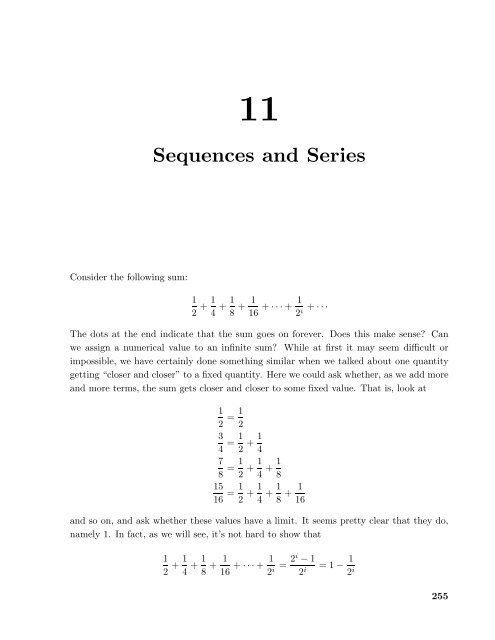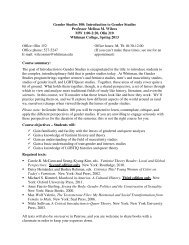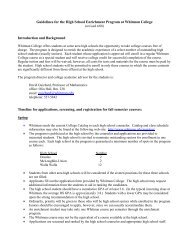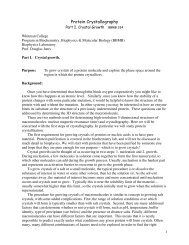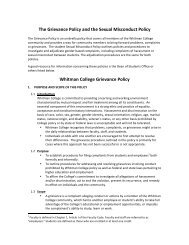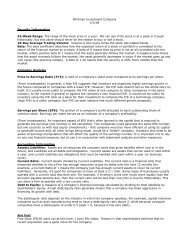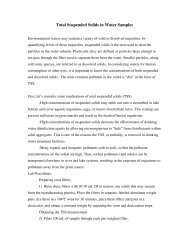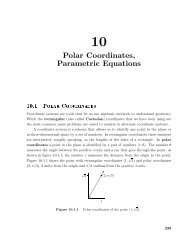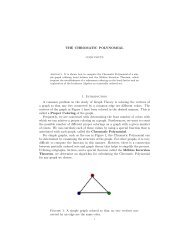Sequences and Series
Sequences and Series
Sequences and Series
You also want an ePaper? Increase the reach of your titles
YUMPU automatically turns print PDFs into web optimized ePapers that Google loves.
260 Chapter 11 <strong>Sequences</strong> <strong>and</strong> <strong>Series</strong>EXAMPLE 11.9 Determine whether {(sinn)/ √ n} ∞ n=1 converges or diverges. If it converges,compute the limit. Since |sinn| ≤ 1, 0 ≤ |sinn/ √ n| ≤ 1/ √ n <strong>and</strong> we can use theorem11.3 with a n = 0 <strong>and</strong> c n = 1/ √ n. Since lim a n = lim c n = 0, lim sinn/√ n = 0n→∞ n→∞ n→∞<strong>and</strong> the sequence converges to 0.EXAMPLE 11.10 A particularly common <strong>and</strong> useful sequence is {r n } ∞ n=0 , for variousvalues of r. Some are quite easy to underst<strong>and</strong>: If r = 1 the sequence converges to 1since every term is 1, <strong>and</strong> likewise if r = 0 the sequence converges to 0. If r = −1 thisis the sequence of example 11.7 <strong>and</strong> diverges. If r > 1 or r < −1 the terms r n get largewithout limit, so the sequence diverges. If 0 < r < 1 then the sequence converges to 0.If −1 < r < 0 then |r n | = |r| n <strong>and</strong> 0 < |r| < 1, so the sequence {|r| n } ∞ n=0 converges to0, so also {r n } ∞ n=0 converges to 0. converges. In summary, {rn } converges precisely when−1 < r ≤ 1 in which case{ 0 if −1 < r < 1limn→∞ rn =1 if r = 1Sometimes we will not be able to determine the limit of a sequence, but we still wouldlike to know whether it converges. In some cases we can determine this even without beingable to compute the limit.A sequence is called increasing or sometimes strictly increasing if a i < a i+1 forall i. It is called non-decreasing or sometimes (unfortunately) increasing if a i ≤ a i+1for all i. Similarly a sequence is decreasing if a i > a i+1 for all i <strong>and</strong> non-increasing ifa i ≥ a i+1 for all i. If a sequence has any of these properties it is called monotonic.EXAMPLE 11.11 The sequence{ 2 i −12 i } ∞i=1= 1 2 , 3 4 , 7 8 , 1516 ,...,is increasing, <strong>and</strong>{ n+1n} ∞i=1= 2 1 , 3 2 , 4 3 , 5 4 ,...is decreasing.A sequence is bounded above if there is some number N such that a n ≤ N for everyn, <strong>and</strong> bounded below if there is some number N such that a n ≥ N for every n. If asequence is bounded above <strong>and</strong> bounded below it is bounded. If a sequence {a n } ∞ n=0 isincreasing or non-decreasing it is bounded below (by a 0 ), <strong>and</strong> if it is decreasing or nonincreasingit is bounded above (by a 0 ). Finally, with all this new terminology we can statean important theorem.
11.1 <strong>Sequences</strong> 261THEOREM 11.12 If a sequence is bounded <strong>and</strong> monotonic then it converges.We will not prove this; the proof appears in many calculus books. It is not hard tobelieve: suppose that a sequence is increasing <strong>and</strong> bounded, so each term is larger than theone before, yet never larger than some fixed value N. The terms must then get closer <strong>and</strong>closer tosome valuebetween a 0 <strong>and</strong>N. Itneed not be N, since N may be a “too-generous”upper bound; the limit will be the smallest number that is above all of the terms a i .EXAMPLE 11.13 All of the terms (2 i − 1)/2 i are less than 2, <strong>and</strong> the sequence isincreasing. As we have seen, the limit of the sequence is 1—1 is the smallest number thatis bigger than all the terms in the sequence. Similarly, all of the terms (n+1)/n are biggerthan 1/2, <strong>and</strong> the limit is 1—1 is the largest number that is smaller than the terms of thesequence.We don’t actually need to know that a sequence is monotonic to apply this theorem—it is enough to know that the sequence is “eventually” monotonic, that is, that at somepoint it becomes increasing or decreasing. For example, the sequence 10, 9, 8, 15, 3, 21, 4,3/4, 7/8, 15/16, 31/32,... is not increasing, because among the first few terms it is not.But starting with the term 3/4 it is increasing, so the theorem tells us that the sequence3/4,7/8,15/16,31/32,... converges. Since convergence depends only on what happens asn gets large, adding a few terms at the beginning can’t turn a convergent sequence into adivergent one.EXAMPLE 11.14 Show that {n 1/n } converges.We first show that this sequence is decreasing, that is, that n 1/n > (n+1) 1/(n+1) . Considerthe real function f(x) = x 1/x when x ≥ 1. We can compute the derivative, f ′ (x) =x 1/x (1−lnx)/x 2 , <strong>and</strong>notethatwhenx ≥ 3thisisnegative. Sincethefunctionhasnegativeslope, n 1/n > (n+1) 1/(n+1) when n ≥ 3. Since all terms of the sequence are positive, thesequence is decreasing <strong>and</strong> bounded when n ≥ 3, <strong>and</strong> so the sequence converges. (As ithappens, we can compute the limit in this case, but we know it converges even withoutknowing the limit; see exercise 1.)EXAMPLE 11.15 Show that {n!/n n } converges.Againwe show that the sequence isdecreasing, <strong>and</strong> since each term is positivethe sequenceconverges. We can’t take the derivative this time, as x! doesn’t make sense for x real. Butwe note that if a n+1 /a n < 1 then a n+1 < a n , which is what we want to know. So we lookat a n+1 /a n :a n+1= (n+1)! n na n (n+1) n+1 n! = (n+1)! n n ( ) n ( ) nn+1 n n= = < 1.n! (n+1)n+1n+1 n+1 n+1
268 Chapter 11 <strong>Sequences</strong> <strong>and</strong> <strong>Series</strong>Therectanglesthistimeareabovethecurve, thatis,eachrectanglecompletelycontainsthe corresponding area under the curve. This means thats n = 1 1 + 1 2 + 1 3 +···+ 1 n > ∫ n+111∣ ∣∣x dx = lnx n+1= ln(n+1).1As n gets bigger, ln(n+1) goes to infinity, so the sequence of partial sums s n must alsogo to infinity, so the harmonic series diverges.The important fact that clinches this example is thatwhich we can rewrite as∫ n+11lim dx = ∞,n→∞1 x∫ ∞11dx = ∞.xSo these two examples taken together indicate that we can prove that a series convergesor prove that it diverges with a single calculation of an improper integral. This is knownas the integral test, which we state as a theorem.THEOREM 11.23 Suppose that f(x) > 0 <strong>and</strong> is decreasing on the infinite interval∞∑[k,∞) (for some k ≥ 1) <strong>and</strong> that a n = f(n). Then the series a n converges if <strong>and</strong> onlyif the improper integral∫ ∞1f(x)dx converges.The two examples we have seen are called p-series; a p-series is any series of the form∑1/n p . If p ≤ 0, limn→∞ 1/np ≠ 0, so the series diverges. For positive values of p we c<strong>and</strong>etermine precisely which series converge.THEOREM 11.24 A p-series with p > 0 converges if <strong>and</strong> only if p > 1.Proof. We use the integral test; we have already done p = 1, so assume that p ≠ 1.n=1∫ ∞11dx = limxp D→∞x 1−p1−p∣D1D 1−p= limD→∞ 1−p − 11−p .If p > 1 then 1−p < 0 <strong>and</strong> limD→∞ D1−p = 0, so the integral converges. If 0 < p < 1 then1−p > 0 <strong>and</strong> limD→∞ D1−p = ∞, so the integral diverges.
EXAMPLE 11.25 Show that∞∑n=11n 3 converges.11.3 The Integral Test 269We could of course use the integral test, but now that we have the theorem we may simplynote that this is a p-series with p > 1.EXAMPLE 11.26 Show thatWe know that if∞∑n=1∞∑1/n 4 converges thenn=1∞∑1/n 4 is a convergent p-series,n=1EXAMPLE 11.27 Show that5n 4 converges.∞∑5/n 4 also converges, by theorem 11.17. Sincen=1∞∑5/n 4 converges also.n=1∞∑n=15√ ndiverges.This also follows from theorem 11.17: Sincediverges, <strong>and</strong> so does∞∑n=15√ n.∞∑n=11√ nis a p-series with p = 1/2 < 1, itSince it is typically difficult to compute the value of a series exactly, a good approximationis frequently required. In a real sense, a good approximation is only as good aswe know it is, that is, while an approximation may in fact be good, it is only valuable inpractice if we can guarantee its accuracy to some degree. This guarantee is usually easyto come by for series with decreasing positive terms.EXAMPLE 11.28 Approximate ∑ 1/n 2 to two decimal places.N∑Referring to figure 11.2, if we approximate the sum by 1/n 2 , the error we make isthe total area of the remaining rectangles, all of which lie under the curve 1/x 2 from x = Nout to infinity. So we know the true value of the series is larger than the approximation,<strong>and</strong> no bigger than the approximation plus the area under the curve from N to infinity.Roughly, then, we need to find N so that∫ ∞N1dx < 1/100.x2 n=1
270 Chapter 11 <strong>Sequences</strong> <strong>and</strong> <strong>Series</strong>We can compute the integral:∫ ∞N1x 2 dx = 1 N ,so N = 100 is a good starting point. Adding up the first 100 terms gives approximately1.634983900, <strong>and</strong> that plus 1/100 is 1.644983900, so approximating the series by the valuehalfwaybetweenthesewillbeatmost1/200 = 0.005inerror. Themidpointis1.639983900,but while this is correct to ±0.005, we can’t tell if the correct two-decimal approximationis 1.63 or 1.64. We need to make N big enough to reduce the guaranteed error, perhaps toaround 0.004 to be safe, so we would need 1/N ≈ 0.008, or N = 125. Now the sum of thefirst 125 terms is approximately 1.636965982, <strong>and</strong> that plus 0.008 is 1.644965982 <strong>and</strong> thepointhalfwaybetweenthemis1.640965982. Thetruevalueisthen1.640965982±0.004,<strong>and</strong>all numbers in this range round to 1.64, so 1.64 is correct to two decimal places. We havementioned that the true value of this series can be shown to be π 2 /6 ≈ 1.644934068 whichrounds down to 1.64 (just barely) <strong>and</strong> is indeed below the upper bound of 1.644965982,again just barely. Frequently approximations will be even better than the “guaranteed”accuracy, but not always, as this example demonstrates.Exercises 11.3.Determine whether each series converges or diverges.∞∑ 11.n ⇒2. ∑ ∞nπ/4 n 2 +1 ⇒3.5.7.n=1∞∑n=1∞∑n=1∞∑n=2lnnn 2 ⇒1e n ⇒1nlnn ⇒9. Find an N so that10. Find an N so that11. Find an N so that12. Find an N so that∞∑n=1∞∑n=0∞∑n=1∞∑n=21n is between ∑ N 4n=11e is between ∑ N nn=0lnnn 2 is between N∑n=11n(lnn) is between ∑ N 2n=14.∞∑n=16.∞∑n=18.∞∑n=21n <strong>and</strong> ∑ N 4n=11e <strong>and</strong> ∑ N nn=01n 2 +1 ⇒ne n ⇒lnnn 2 <strong>and</strong> N∑n=21n(lnn) 2 ⇒1n 4 +0.005. ⇒1e n +10−4 . ⇒n=11n(lnn) <strong>and</strong> ∑ N 2lnnn 2 +0.005. ⇒n=21n(lnn) 2 +0.005. ⇒
½½º ÐØÖÒØÒËÖ×11.4 Alternating <strong>Series</strong> 271Next we consider series with both positive <strong>and</strong> negative terms, but in a regular pattern:they alternate, as in the alternating harmonic series for example:∞∑ (−1) n−1n=1n= 1 1 + −12 + 1 3 + −14 +··· = 1 1 − 1 2 + 1 3 − 1 4 +···.In this series the sizes of the terms decrease, that is, |a n | forms a decreasing sequence,but this is not required in an alternating series. As with positive term series, however,when the terms do have decreasing sizes it is easier to analyze the series, much easier, infact, than positive term series. Consider pictorially what is going on in the alternatingharmonic series, shown in figure 11.4. Because the sizes of the terms a n are decreasing,the partial sums s 1 , s 3 , s 5 , <strong>and</strong> so on, form a decreasing sequence that is bounded belowby s 2 , so this sequence must converge. Likewise, the partial sums s 2 , s 4 , s 6 , <strong>and</strong> so on,form an increasing sequence that is bounded above by s 1 , so this sequence also converges.Since all the even numbered partial sums are less than all the odd numbered ones, <strong>and</strong>since the “jumps” (that is, the a i terms) are getting smaller <strong>and</strong> smaller, the two sequencesmust converge to the same value, meaning the entire sequence of partial sums s 1 ,s 2 ,s 3 ,...converges as well.14s 2 = 1 2s 6...a 2 = − 1 2a 4a 6s 4 s 5 s 3a 5. .a 31 = s 1 = a 1Figure 11.4 The alternating harmonic series.There’s nothing special about the alternating harmonic series—the same argumentworks for any alternating sequence with decreasing size terms. The alternating series testis worth calling a theorem.THEOREM 11.29 Suppose that{a n } ∞ n=1 isanon-increasing sequence ofpositivenumbers<strong>and</strong> lim a n = 0. Then the alternating series (−1) n−1 a n converges.∞∑n→∞Proof. The odd numbered partial sums, s 1 , s 3 , s 5 , <strong>and</strong> so on, form a non-increasingsequence, because s 2k+3 = s 2k+1 − a 2k+2 + a 2k+3 ≤ s 2k+1 , since a 2k+2 ≥ a 2k+3 . Thisn=1
272 Chapter 11 <strong>Sequences</strong> <strong>and</strong> <strong>Series</strong>sequence is bounded below by s 2 , so it must converge, say lim s 2k+1 = L. Likewise,k→∞the partial sums s 2 , s 4 , s 6 , <strong>and</strong> so on, form a non-decreasing sequence that is boundedabove by s 1 , so this sequence also converges, say lim s 2k = M. Since lim a n = 0 <strong>and</strong>k→∞ n→∞s 2k+1 = s 2k +a 2k+1 ,L = limk→∞ s 2k+1 = limk→∞ (s 2k +a 2k+1 ) = limk→∞ s 2k + limk→∞ a 2k+1 = M +0 = M,so L = M, the two sequences of partial sums converge to the same limit, <strong>and</strong> this meansthe entire sequence of partial sums also converges to L.Another useful fact is implicit in this discussion. Suppose thatL =∞∑(−1) n−1 a nn=1<strong>and</strong> that we approximate L by a finite part of this sum, sayL ≈N∑(−1) n−1 a n .n=1Because the terms are decreasing in size, we know that the true value of L must be betweenthis approximation <strong>and</strong> the next one, that is, betweenN∑(−1) n−1 a nn=1<strong>and</strong>N+1∑(−1) n−1 a n .n=1Depending on whether N is odd or even, the second will be larger or smaller than the first.EXAMPLE 11.30 Approximate the alternating harmonic series to one decimal place.We need to go roughly to the point at which the next term to be added or subtractedis 1/10. Adding up the first nine <strong>and</strong> the first ten terms we get approximately 0.746 <strong>and</strong>0.646. These are 1/10 apart, but it is not clear how the correct value would be rounded. Itturns out that we are able to settle the question by computing the sums of the first eleven<strong>and</strong> twelve terms, which give 0.737 <strong>and</strong> 0.653, so correct to one place the value is 0.7.We have considered alternating series with first index 1, <strong>and</strong> in which the first term ispositive, but a little thought shows this is not crucial. The same test applies to any similar∞∑ ∞∑ ∞∑series, such as (−1) n a n , (−1) n a n , (−1) n a n , etc.n=0n=1n=17
11.5 Comparison Tests 273Exercises 11.4.Determine whether the following series converge or diverge.∞∑ (−1) n−1∞1.2n+5 ⇒ 2. ∑ (−1) n−1√ ⇒ n−33.n=1∞∑(−1) n−1 n3n−2 ⇒n=1n=4∞ 4. ∑(−1) n−1 lnnn ⇒∞∑5. Approximate (−1) n−1 1½½º ÓÑÔÖ×ÓÒÌ×Ø×to two decimal places. ⇒n3 n=1∞∑6. Approximate (−1) n−1 1to two decimal places. ⇒n4 n=1As we begin to compile a list of convergent <strong>and</strong> divergent series, new ones can sometimesbe analyzed by comparing them to ones that we already underst<strong>and</strong>.EXAMPLE 11.31 Does∞∑n=21n 2 lnn converge?Theobviousfirst approach, basedonwhatweknow, istheintegraltest. Unfortunately,we can’t compute the required antiderivative. But looking at the series, it would appearthat it must converge, because the terms we are adding are smaller than the terms of ap-series, that is,1n 2 lnn < 1 n 2,when n ≥ 3. Since adding up the terms 1/n 2 doesn’t get “too big”, the new series “should”also converge. Let’s make this more precise.∞∑ 1The seriesn 2 lnn converges if <strong>and</strong> only if ∑ ∞1converges—all we’ve done isn 2 lnnn=2n=3∞∑ 1dropped the initial term. We know that converges. Looking at two typical partialn2 n=3sums:s n = 13 2 ln3 + 14 2 ln4 + 15 2 ln5 +···+ 1n 2 lnn < 1 3 2 + 1 4 2 + 1 5 2 +···+ 1 n 2 = t n.Since the p-series converges, say to L, <strong>and</strong> since the terms are positive, t n < L. Since theterms of the new series are positive, the s n form an increasing sequence <strong>and</strong> s n < t n < Lfor all n. Hence the sequence {s n } is bounded <strong>and</strong> so converges.n=1
274 Chapter 11 <strong>Sequences</strong> <strong>and</strong> <strong>Series</strong>Sometimes, even when the integral test applies, comparison to a known series is easier,so it’s generally a good idea to think about doing a comparison before doing the integraltest.EXAMPLE 11.32 Does∞∑n=2|sinn|n 2converge?Wecan’tapplytheintegraltesthere, becausethetermsofthisseriesarenotdecreasing.Just as in the previous example, however,|sinn|n 2 ≤ 1 n 2,because |sinn| ≤ 1. Once again the partial sums are non-decreasing <strong>and</strong> bounded aboveby ∑ 1/n 2 = L, so the new series converges.Like the integral test, the comparison test can be used to show both convergence <strong>and</strong>divergence. In the case of the integral test, a single calculation will confirm whichever isthe case. To use the comparison test we must first have a good idea as to convergence ordivergence <strong>and</strong> pick the sequence for comparison accordingly.EXAMPLE 11.33 Does∞∑n=21√n2 −3 converge?We observe that the −3 should have little effect compared to the n 2 inside the squareroot, <strong>and</strong> therefore guess that the terms are enough like 1/ √ n 2 = 1/n that the seriesshould diverge. We attempt to show this by comparison to the harmonic series. We notethat1√n2 −3 > √ 1 = 1 n2 n ,so thats n =1√22 −3 + 1√32 −3 +···+ 1√n2 −3 > 1 2 + 1 3 +···+ 1 n = t n,where t n is 1 less than the corresponding partial sum of the harmonic series (because westart at n = 2 instead of n = 1). Since lim t n = ∞, lim s n = ∞ as well.n→∞ n→∞So the general approach is this: If you believe that a new series is convergent, attemptto find a convergent series whose terms are larger than the terms of the new series; if youbelieve that a new series is divergent, attempt to find a divergent series whose terms aresmaller than the terms of the new series.
EXAMPLE 11.34 Does∞∑n=11√n2 +3 converge?11.5 Comparison Tests 275Just as in the last example, we guess that this is very much like the harmonic series<strong>and</strong> so diverges. Unfortunately,1√n2 +3 < 1 n ,so we can’t compare the series directly to the harmonic series. A little thought leads us to1√n2 +3 > 1√n2 +3n = 12 2n ,so if ∑ 1/(2n) diverges then the given series diverges. But since ∑ 1/(2n) = (1/2) ∑ 1/n,theorem 11.17 implies that it does indeed diverge.For reference we summarize the comparison test in a theorem.THEOREM 11.35 Suppose that a n <strong>and</strong> b n are non-negative for all n <strong>and</strong> that a n ≤ b nwhen n ≥ N, for some N.∞∑∞∑If b n converges, so does a n .Ifn=0∞∑a n diverges, so doesn=0∞∑b n .n=0n=0Exercises 11.5.Determine whether the series converge or diverge.∞∑∞11.2n 2 +3n+5 ⇒2. ∑ 12n 2 +3n−5 ⇒3.5.7.9.n=1∞∑n=1∞∑n=1∞∑n=1∞∑n=112n 2 −3n−5 ⇒3n 2 +42n 2 +3n+5 ⇒lnnn 3 ⇒n=24.∞∑n=16.∞∑n=18.∞∑n=23n+42n 2 +3n+5 ⇒lnnn ⇒1lnn ⇒3 n2 n +5 ⇒ 10. ∑ ∞3 nn 2 n +3 ⇒ nn=1
½½º ×ÓÐÙØÓÒÚÖÒ276 Chapter 11 <strong>Sequences</strong> <strong>and</strong> <strong>Series</strong>Roughly speaking there are two ways for a series to converge: As in the case of ∑ 1/n 2 ,the individual terms get small very quickly, so that the sum of all of them stays finite, or,as in the case of ∑ (−1) n−1 /n, the terms don’t get small fast enough ( ∑ 1/n diverges),but a mixture of positive <strong>and</strong> negative terms provides enough cancellation to keep thesum finite. You might guess from what we’ve seen that if the terms get small fast enoughto do the job, then whether or not some terms are negative <strong>and</strong> some positive the seriesconverges.THEOREM 11.36 If∞∑|a n | converges, thenn=0∞∑a n converges.n=0Proof. Notethat0 ≤ a n +|a n | ≤ 2|a n |sobythecomparisontestNow∞∑(a n +|a n |)−n=0converges by theorem 11.17.∞∑|a n | =n=0∞∑a n +|a n |−|a n | =n=0∞∑(a n +|a n |)converges.So given a series ∑ a n with both positive <strong>and</strong> negative terms, you should first askwhether ∑ |a n | converges. This may be an easier question to answer, because we havetests that apply specifically to terms with non-negative terms. If ∑ |a n | converges thenyou know that ∑ a n converges as well. If ∑ |a n | diverges then it still may be true that∑an converges—you will have to do more work to decide the question. Another way tothink of this result is: it is (potentially) easier for ∑ a n to converge than for ∑ |a n | toconverge, because the latter series cannot take advantage of cancellation.If ∑ |a n |convergeswesaythat ∑ a n convergesabsolutely; tosaythat ∑ a n convergesabsolutely is to say that any cancellation that happens to come along is not really needed,as the terms already get small so fast that convergence is guaranteed by that alone. If∑an converges but ∑ |a n | does not, we say that ∑ a n converges conditionally. Forn=0∞∑n=0a nexample∞∑(−1) n−1 1 n converges absolutely, while ∑∞ (−1) n−11 2 nn=1n=1converges conditionally.EXAMPLE 11.37 Does∞∑n=2sinnn 2 converge?
In example 11.32 we saw thatconverges, so the given series converges absolutely.∞∑n=2|sinn|n 211.7 The Ratio <strong>and</strong> Root Tests 277EXAMPLE 11.38 DoesTaking the absolute value,∞∑(−1) n 3n+42n 2 +3n+5 converge?n=0∞∑n=03n+4∞2n 2 +3n+5 diverges by comparison to ∑ 3, so if the10nseries converges it does so conditionally. It is true that limn→∞ (3n+4)/(2n2 +3n+5) = 0,so to apply the alternating series test we need to know whether the terms are decreasing.If we let f(x) = (3x+4)/(2x 2 +3x+5) then f ′ (x) = −(6x 2 +16x−3)/(2x 2 +3x+5) 2 ,<strong>and</strong> it is not hard to see that this is negative for x ≥ 1, so the series is decreasing <strong>and</strong> bythe alternating series test it converges.Exercises 11.6.Determine whether each series converges absolutely, converges conditionally, or diverges.∞∑1. (−1) n−1 12n 2 +3n+5 ⇒ 2. ∑ ∞(−1) n−1 3n 2 +42n 2 +3n+5 ⇒n=1n=1∞∑3. (−1) n−1 lnnn ⇒4. ∑ ∞(−1) n−1 lnnn ⇒ 3 n=1n=1∞∑5. (−1) n 1lnn ⇒6. ∑ ∞(−1) n 3 n½½º ÌÊØÓÒÊÓÓØÌ×Ø×2 n +5 ⇒ n n=2n=0∞∑7. (−1) n 3 n∞2 n +3 ⇒ 8. ∑(−1) n−1 arctann⇒n nn=0n=1∞∑ n 5Does the series converge? It is possible, but a bit unpleasant, to approach this5n n=0with the integral test or the comparison test, but there is an easier way. Consider whathappens as we move from one term to the next in this series:···+ n55 n + (n+1)55 n+1 +···The denominator goes up by a factor of 5, 5 n+1 = 5 ·5 n , but the numerator goes up bymuch less: (n+1) 5 = n 5 +5n 4 +10n 3 +10n 2 +5n+1, which is much less than 5n 5 whenn is large, because 5n 4 is much less than n 5 . So we might guess that in the long run itn=1
278 Chapter 11 <strong>Sequences</strong> <strong>and</strong> <strong>Series</strong>begins to look as if each term is 1/5 of the previous term. We have seen series that behavelike this:∞∑ 15 n = 5 4 ,n=0a geometric series. So we might try comparing the given series to some variation of thisgeometric series. This is possible, but a bit messy. We can in effect do the same thing,but bypass most of the unpleasant work.The key is to notice thata n+1 (n+1) 5 5 nlim = limn→∞ a n n→∞ 5 n+1 n 5 = lim (n+1) 5 1n→∞ n 5 5 = 1· 15 = 1 5 .This is really just what we noticed above, done a bit more officially: in the long run, eachterm is one fifth of the previous term. Now pick some number between 1/5 <strong>and</strong> 1, say 1/2.Becausea n+1lim = 1n→∞ a n 5 ,then when n is big enough, say n ≥ N for some N,a n+1a n< 1 2<strong>and</strong> a n+1 < a n2 .So a N+1 < a N /2, a N+2 < a N+1 /2 < a N /4, a N+3 < a N+2 /2 < a N+1 /4 < a N /8, <strong>and</strong> soon. The general form is a N+k < a N /2 k . So if we look at the series∞∑a N+k = a N +a N+1 +a N+2 +a N+3 +···+a N+k +···,k=0its terms are less than or equal to the terms of the sequenceSo by the comparison test,a N + a N2 + a N4 + a N8 +···+ a N2 k +··· = ∞ ∑k=0a N2 k = 2a N.∞∑a N+k converges, <strong>and</strong> this means thatk=0∞∑a n converges,since we’ve just added the fixed number a 0 +a 1 +···+a N−1 .Under what circumstances could we do this? What was crucial was that the limit ofa n+1 /a n , say L, was less than 1 so that we could pick a value r so that L < r < 1. Thefact that L < r (1/5 < 1/2 in our example) means that we can compare the series ∑ a nto ∑ r n , <strong>and</strong> the fact that r < 1 guarantees that ∑ r n converges. That’s really all that isn=0
11.7 The Ratio <strong>and</strong> Root Tests 279required to make the argument work. We also made use of the fact that the terms of theseries were positive; in general we simply consider the absolute values of the terms <strong>and</strong> weend up testing for absolute convergence.THEOREM 11.39 The Ratio Test Suppose that lim |a n+1/a n | = L. If L < 1n→∞the series ∑ a n converges absolutely, if L > 1 the series diverges, <strong>and</strong> if L = 1 this testgives no information.Proof. The example above essentially proves the first part of this, if we simply replace1/5 by L <strong>and</strong> 1/2 by r. Suppose that L > 1, <strong>and</strong> pick r so that 1 < r < L. Then forn ≥ N, for some N,|a n+1 |> r <strong>and</strong> |a n+1 | > r|a n |.|a n |This implies that |a N+k | > r k |a N |, but since r > 1 this means that limk→∞ |a N+k| ≠ 0, whichmeans also that limn→∞ a n ≠ 0. By the divergence test, the series diverges.To see that we get no information when L = 1, we need to exhibit two series withL = 1, one that converges <strong>and</strong> one that diverges. It is easy to see that ∑ 1/n 2 <strong>and</strong> ∑ 1/ndo the job.EXAMPLE 11.40 The ratio test is particularly useful for series involving the factorial∞∑function. Consider 5 n /n!.limn→∞n=0Since 0 < 1, the series converges.5 n+1 n!(n+1)! 5 n = lim 5 n+1 n!n→∞ 5 n (n+1)! = lim 5 1n→∞ (n+1) = 0.A similar argument, which we will not do, justifies a similar test that is occasionallyeasier to apply.THEOREM 11.41 The Root Test Suppose that lim |a n| 1/n = L. If L < 1 then→∞series ∑ a n converges absolutely, if L > 1 the series diverges, <strong>and</strong> if L = 1 this test givesno information.The proof of the root test is actually easier than that of the ratio test, <strong>and</strong> is a goodexercise.EXAMPLE 11.42 Analyze∞∑n=05 nn n.
280 Chapter 11 <strong>Sequences</strong> <strong>and</strong> <strong>Series</strong>The ratio test turns out to be a bit difficult on this series (try it). Using the root test:Since 0 < 1, the series converges.( ) 5n 1/n(5 n ) 1/n 5lim = lim = limn→∞ n n n→∞ (n n )1/n n→∞ n = 0.The root test is frequently useful when n appears as an exponent in the general termof the series.Exercises 11.7.1. Compute limn→∞ |a n+1/a n | for the series ∑ 1/n 2 .2. Compute limn→∞ |a n+1/a n | for the series ∑ 1/n.3. Compute limn→∞ |a n| 1/n for the series ∑ 1/n 2 .4. Compute limn→∞ |a n| 1/n for the series ∑ 1/n.Determine whether the series converge.∞∑5. (−1) n 3 n5 ⇒ 6. ∑ ∞n!n n ⇒ n½½ºn=0n=1∞∑ÈÓÛÖËÖ×n 5∞7.n ⇒8. ∑ (n!) 2n n ⇒ nn=1n=19. Prove theorem 11.41, the root test.Recall that we were able to analyze all geometric series “simultaneously” to discover that∞∑n=0kx n = k1−x ,if |x| < 1, <strong>and</strong> that the series diverges when |x| ≥ 1. At the time, we thought of x as anunspecified constant, but we could just as well think of it as a variable, in which case theseries∞∑kx nn=0is a function, namely, the function k/(1−x), as long as |x| < 1. While k/(1−x) is a reasonablyeasy function to deal with, the more complicated ∑ kx n does have its attractions:it appears to be an infinite version of one of the simplest function types—a polynomial.
11.8 Power <strong>Series</strong> 281This leads naturally to the questions: Do other functions have representations as series?Is there an advantage to viewing them in this way?The geometric series has a special feature that makes it unlike a typical polynomial—the coefficients of the powers of x are the same, namely k. We will need to allow moregeneral coefficients if we are to get anything other than the geometric series.DEFINITION 11.43 A power series has the form∞∑a n x n ,n=0with the underst<strong>and</strong>ing that a n may depend on n but not on x.EXAMPLE 11.44ratio test:∞∑n=1x nnis a power series. We can investigate convergence using the|x| n+1 nlimn→∞ n+1 |x| n = lim |x| nn→∞ n+1 = |x|.Thuswhen|x| < 1theseriesconverges<strong>and</strong>when|x| > 1itdiverges, leavingonlytwo valuesin doubt. When x = 1 the series is the harmonic series <strong>and</strong> diverges; when x = −1 it is thealternating harmonic series (actually the negative of the usual alternating harmonic series)<strong>and</strong> converges. Thus, we may think ofthe real numbers.∞∑n=1x nnas a function from the interval [−1,1) toA bit of thought reveals that the ratio test applied to a power series will always havethe same nice form. In general, we will compute|a n+1 ||x| n+1lim = limn→∞ |a n ||x| |x||a n+1|n n→∞ |a n ||a n+1 |= |x| limn→∞ |a n |= L|x|,assuming that lim|a n+1 |/|a n | exists. Then the series converges if L|x| < 1, that is, if|x| < 1/L, <strong>and</strong> diverges if |x| > 1/L. Only the two values x = ±1/L require furtherinvestigation. Thus the series will definitely define a function on the interval (−1/L,1/L),<strong>and</strong> perhaps will extend to one or both endpoints as well. Two special cases deservemention: if L = 0 the limit is 0 no matter what value x takes, so the series converges forall x <strong>and</strong> the function is defined for all real numbers. If L = ∞, then no matter whatvalue x takes the limit is infinite <strong>and</strong> the series converges only when x = 0. The value 1/Lis called the radius of convergence of the series, <strong>and</strong> the interval on which the seriesconverges is the interval of convergence.
282 Chapter 11 <strong>Sequences</strong> <strong>and</strong> <strong>Series</strong>Consider again the geometric series,∞∑n=0x n = 11−x .Whatever benefits there might be in using the series form of this function are only availableto us when x is between −1 <strong>and</strong> 1. Frequently we can address this shortcoming bymodifying the power series slightly. Consider this series:∞∑n=0(x+2) n3 n =∞∑( ) n x+2=3n=011− x+23= 31−x ,because this is just a geometric series with x replaced by (x+2)/3. Multiplying both sidesby 1/3 gives∞∑ (x+2) n= 13 n+1 1−x ,n=0the same function as before. For what values of x does this series converge? Since it is ageometric series, we know that it converges when|x+2|/3 < 1|x+2| < 3−3 < x+2 < 3−5 < x < 1.So we have a series representation for 1/(1−x) that works on a larger interval than before,at the expense of a somewhat more complicated series. The endpoints of the interval ofconvergence now are −5 <strong>and</strong> 1, but note that they can be more compactly described as−2 ± 3. We say that 3 is the radius of convergence, <strong>and</strong> we now say that the series iscentered at −2.DEFINITION 11.45 A power series centered at a has the form∞∑a n (x−a) n ,n=0with the underst<strong>and</strong>ing that a n may depend on n but not on x.
11.9 Calculus with Power <strong>Series</strong> 283Exercises 11.8.Find the radius <strong>and</strong> interval of convergence for each series. In exercises 3 <strong>and</strong> 4, do not attemptto determine whether the endpoints are in the interval of convergence.∞∑∞∑1. nx n x n⇒ 2. ⇒n!n=0n=0∞∑ n!∞∑ n!½½º3. ⇒ 4.n nxn ÐÙÐÙ×ÛØÈÓÛÖËÖ×⇒n n(x−2)n n=1n=1∞∑ (n!) 2∞∑ (x+5) n5.n n (x−2)n ⇒ 6.n(n+1) ⇒n=1n=1Now we know that some functions can be expressed as power series, which look like infinitepolynomials. Since calculus, that is, computation of derivatives <strong>and</strong> antiderivatives, is easyfor polynomials, the obvious question is whether the same is true for infinite series. Theanswer is yes:THEOREM 11.46 Suppose the power series f(x) =convergence R. Then∫f ′ (x) =∞∑na n (x−a) n−1 ,n=0f(x)dx = C +∞∑n=0∞∑a n (x − a) n has radius ofn=0a nn+1 (x−a)n+1 ,<strong>and</strong> these two series have radius of convergence R as well.EXAMPLE 11.47 Starting with the geometric series:∫1∞1−x = ∑n=0x n1∞1−x dx = −ln|1−x| = ∑ 1n+1 xn+1ln|1−x| =∞∑n=0n=0− 1n+1 xn+1when |x| < 1. The series does not converge when x = 1 but does converge when x = −1or 1−x = 2. The interval of convergence is [−1,1), or 0 < 1−x ≤ 2, so we can use the
284 Chapter 11 <strong>Sequences</strong> <strong>and</strong> <strong>Series</strong>series to represent ln(x) when 0 < x ≤ 2. For example<strong>and</strong> soln(3/2) = ln(1−−1/2) =∞∑(−1) n 1 1n+12 n+1n=0ln(3/2) ≈ 1 2 − 1 8 + 124 − 164 + 1160 − 1384 + 1896 = 9092240 ≈ 0.406.Because this is an alternating series with decreasing terms, we know that the true valueis between 909/2240 <strong>and</strong> 909/2240 − 1/2048 = 29053/71680 ≈ .4053, so correct to twodecimal places the value is 0.41.What about ln(9/4)? Since 9/4 is larger than 2 we cannot use the series directly, butln(9/4) = ln((3/2) 2 ) = 2ln(3/2) ≈ 0.82,so in fact we get a lot more from this one calculation than first meets the eye. To estimatethe true value accurately we actually need to be a bit more careful. When we multiply bytwo we know that the true value is between 0.8106 <strong>and</strong> 0.812, so rounded to two decimalplaces the true value is 0.81.Exercises 11.9.1. Find a series representation for ln2. ⇒2. Find a power series representation for 1/(1−x) 2 . ⇒½½º½¼3. Find a powerÌÝÐÓÖËÖ×series representation for 2/(1−x) 3 . ⇒4. Find a power series representation for 1/(1−x) 3 . What is the radius of convergence? ⇒∫5. Find a power series representation for ln(1−x)dx. ⇒We have seen that some functions can be represented as series, which may give valuableinformation about the function. So far, we have seen only those examples that result frommanipulation of our one fundamental example, the geometric series. We would like to startwith a given function <strong>and</strong> produce a series to represent it, if possible.∞∑Suppose that f(x) = a n x n on some interval of convergence. Then we know thatn=0we can compute derivatives of f by taking derivatives of the terms of the series. Let’s look
11.10 Taylor <strong>Series</strong> 285at the first few in general:f ′ (x) =f ′′ (x) =f ′′′ (x) =∞∑na n x n−1 = a 1 +2a 2 x+3a 3 x 2 +4a 4 x 3 +···n=1∞∑n(n−1)a n x n−2 = 2a 2 +3·2a 3 x+4·3a 4 x 2 +···n=2∞∑n(n−1)(n−2)a n x n−3 = 3·2a 3 +4·3·2a 4 x+···n=3By examining these it’s not hard to discern the general pattern. The kth derivative mustbe∞∑f (k) (x) = n(n−1)(n−2)···(n−k +1)a n x n−kn=k= k(k −1)(k−2)···(2)(1)a k +(k +1)(k)···(2)a k+1 x++(k+2)(k +1)···(3)a k+2 x 2 +···We can shrink this quite a bit by using factorial notation:f (k) (x) =∞∑ n!(n−k)! a nx n−k = k!a k +(k+1)!a k+1 x+ (k+2)! a k+2 x 2 +···2!n=kNow substitute x = 0:<strong>and</strong> solve for a k :f (k) (0) = k!a k +∞∑n=k+1n!(n−k)! a n0 n−k = k!a k ,a k = f(k) (0).k!Note the special case, obtained from the series for f itself, that gives f(0) = a 0 .So if a function f can be represented by a series, we know just what series it is. Givena function f, the series∞∑ f (n) (0)x nn!is called the Maclaurin series for f.n=0
286 Chapter 11 <strong>Sequences</strong> <strong>and</strong> <strong>Series</strong>EXAMPLE 11.48 Find the Maclaurin series for f(x) = 1/(1−x). We need to computethe derivatives of f (<strong>and</strong> hope to spot a pattern).f(x) = (1−x) −1f ′ (x) = (1−x) −2f ′′ (x) = 2(1−x) −3f ′′′ (x) = 6(1−x) −4f (4) = 4!(1−x) −5.f (n) = n!(1−x) −n−1So<strong>and</strong> the Maclaurin series isthe geometric series.f (n) (0)n!= n!(1−0)−n−1n!∞∑1·x n =n=0∞∑x n ,n=0= 1A warning is in order here. Given a function f we may be able to compute theMaclaurin series, but that does not mean we have found a series representation for f. Westill need to know where the series converges, <strong>and</strong> if, where it converges, it converges tof(x). While for most commonly encountered functions the Maclaurin series does indeedconverge to f on some interval, this is not true of all functions, so care is required.As a practical matter, if we are interested in using a series to approximate a function,we will need some finite number of terms of the series. Even for functions with messyderivativeswecancomputetheseusingcomputersoftwarelikeSage. Ifwewanttoknowthewhole series, that is, a typical term in the series, we need a function whose derivatives fallinto a pattern that we can discern. A few of the most important functions are fortunatelyvery easy.EXAMPLE 11.49 Find the Maclaurin series for sinx.The derivatives are quite easy: f ′ (x) = cosx, f ′′ (x) = −sinx, f ′′′ (x) = −cosx,f (4) (x) = sinx, <strong>and</strong> then the pattern repeats. We want to know the derivatives at zero: 1,
11.10 Taylor <strong>Series</strong> 2870, −1, 0, 1, 0, −1, 0,..., <strong>and</strong> so the Maclaurin series isx− x33! + x5∞ 5! −··· = ∑n=0We should always determine the radius of convergence:limn→∞|x| 2n+3 (2n+1)!(2n+3)! |x| 2n+1 = limn→∞(−1) n x2n+1(2n+1)! .|x| 2(2n+3)(2n+2) = 0,so the series converges for every x. Since it turns out that this series does indeed convergeto sinx everywhere, we have a series representation for sinx for every x. Here is aninteractive plot of the sine <strong>and</strong> some of its series approximations.Sometimes the formula for the nth derivative of a function f is difficult to discover,but a combination of a known Maclaurin series <strong>and</strong> some algebraic manipulation leadseasily to the Maclaurin series for f.EXAMPLE 11.50 Find the Maclaurin series for xsin(−x).To get from sinx to xsin(−x) we substitute −x for x <strong>and</strong> then multiply by x. We c<strong>and</strong>o the same thing to the series for sinx:x∞∑n=0∞ (2n+1)! = x ∑(−1) n (−1) 2n+1 x 2n+1 ∞(2n+1)! = ∑(−1) n+1 x 2n+2(2n+1)! .(−1) n(−x)2n+1n=0n=0As we have seen, a general power series can be centered at a point other than zero,<strong>and</strong> the method that produces the Maclaurin series can also produce such series.EXAMPLE 11.51 Find a series centered at −2 for 1/(1−x).∞∑If the series is a n (x+2) n then looking at the kth derivative:n=0k!(1−x) −k−1 =∞∑n=kn!(n−k)! a n(x+2) n−k<strong>and</strong> substituting x = −2 we get k!3 −k−1 = k!a k <strong>and</strong> a k = 3 −k−1 = 1/3 k+1 , so the series isWe’ve already seen this, on page 282.∞∑n=0(x+2) n3 n+1 .
288 Chapter 11 <strong>Sequences</strong> <strong>and</strong> <strong>Series</strong>Such a series is called the Taylor series for the function, <strong>and</strong> the general term hasthe formf (n) (a)(x−a) n .n!A Maclaurin series is simply a Taylor series with a = 0.Exercises 11.10.For each function, find the Maclaurin series or Taylor series centered at a, <strong>and</strong> the radius ofconvergence.1. cosx ⇒2. e x ⇒3. 1/x, a = 5 ⇒4. lnx, a = 1 ⇒5. lnx, a = 2 ⇒6. 1/x 2 , a = 1 ⇒7. 1/ √ 1−x ⇒8. Find the first four terms of the Maclaurin series for tanx (up to <strong>and</strong> including the x 3 term).⇒½½º½½9. Use a combinationÌÝÐÓÖ³×ÌÓÖÑof Maclaurin series <strong>and</strong> algebraic manipulation to find a series centeredat zero for xcos(x 2 ). ⇒10. Use a combination of Maclaurin series <strong>and</strong> algebraic manipulation to find a series centeredat zero for xe −x . ⇒One of the most important uses of infinite series is the potential for using an initial portionof the series for f to approximate f. We have seen, for example, that when we add up thefirst n terms of an alternating series with decreasing terms that the difference between this<strong>and</strong> the true value is at most the size of the next term. A similar result is true of manyTaylor series.THEOREM 11.52 Suppose that f is defined on some open interval I around a <strong>and</strong>suppose f (N+1) (x) exists on this interval. Then for each x ≠ a in I there is a value zbetween x <strong>and</strong> a so thatf(x) =N∑n=0f (n) (a)n!(x−a) n + f(N+1) (z)(N +1)! (x−a)N+1 .
11.11 Taylor’s Theorem 289Proof. The proof requires some cleverness to set up, but then the details are quiteelementary. We want to define a function F(t). Start with the equationF(t) =N∑n=0f (n) (t)n!(x−t) n +B(x−t) N+1 .Here we have replaced a by t in the first N + 1 terms of the Taylor series, <strong>and</strong> added acarefully chosen term on the end, with B to be determined. Note that we are temporarilykeeping x fixed, so the only variable in this equation is t, <strong>and</strong> we will be interested only int between a <strong>and</strong> x. Now substitute t = a:Set this equal to f(x):F(a) =N∑n=0f (n) (a)n!(x−a) n +B(x−a) N+1 .f(x) =N∑n=0f (n) (a)n!(x−a) n +B(x−a) N+1 .Since x ≠ a, we can solve this for B, which is a “constant”—it depends on x <strong>and</strong> a butthose are temporarily fixed. Now we have defined a function F(t) with the property thatF(a) = f(x). Consider also F(x): all terms with a positive power of (x−t) become zerowhen we substitute x for t, so we are left with F(x) = f (0) (x)/0! = f(x). So F(t) is afunction with the same value on the endpoints of the interval [a,x]. By Rolle’s theorem(6.25), we know that there is a value z ∈ (a,x) such that F ′ (z) = 0. Let’s look at F ′ (t).Each term in F(t), except the first term <strong>and</strong> the extra term involving B, is a product, soto take the derivative we use the product rule on each of these terms. It will help to writeout the first few terms of the definition:F(t) = f(t)+ f(1) (t)1!(x−t) 1 + f(2) (t)2!+ f(N) (t)(x−t) N +B(x−t) N+1 .N!(x−t) 2 + f(3) (t)(x−t) 3 +···3!
290 Chapter 11 <strong>Sequences</strong> <strong>and</strong> <strong>Series</strong>Now take the derivative:( fF ′ (t) = f ′ (1) (t)(t)+1!( f (2) (t)+1!( f (3) (t)+2!( f (N) (t)+)(x−t) 0 (−1)+ f(2) (t)(x−t) 11!)(x−t) 1 (−1)+ f(3) (t)(x−t) 22!(x−t) 2 (−1)+ f(4) (t)(x−t))+...+33!)(N −1)! (x−t)N−1 (−1)+ f(N+1) (t)(x−t) NN!+B(N +1)(x−t) N (−1).Now most of the terms in this expression cancel out, leaving justAt some z, F ′ (z) = 0 soNow we can writeF ′ (t) = f(N+1) (t)(x−t) N +B(N +1)(x−t) N (−1).N!0 = f(N+1) (z)(x−z) N +B(N +1)(x−z) N (−1)N!B(N +1)(x−z) N = f(N+1) (z)(x−z) NN!F(t) =B = f(N+1) (z)(N +1)! .N∑n=0f (n) (t)n!Recalling that F(a) = f(x) we getf(x) =N∑n=0f (n) (a)n!which is what we wanted to show.(x−t) n + f(N+1) (z)(N +1)! (x−t)N+1 .(x−a) n + f(N+1) (z)(N +1)! (x−a)N+1 ,It may not be immediately obvious that this is particularly useful; let’s look at someexamples.
11.11 Taylor’s Theorem 291EXAMPLE 11.53 Find a polynomial approximation for sinx accurate to ±0.005.From Taylor’s theorem:sinx =N∑n=0f (n) (a)n!What can we say about the size of the term(x−a) n + f(N+1) (z)(N +1)! (x−a)N+1 .f (N+1) (z)(N +1)! (x−a)N+1 ?Every derivative of sinx is ±sinx or ±cosx, so |f (N+1) (z)| ≤ 1. The factor (x−a) N+1 isa bit more difficult, since x−a could be quite large. Let’s pick a = 0 <strong>and</strong> |x| ≤ π/2; if wecan compute sinx for x ∈ [−π/2,π/2], we can of course compute sinx for all x.We need to pick N so thatSince we have limited x to [−π/2,π/2],x N+1∣(N +1)! ∣ < 0.005.x N+1∣(N +1)! ∣ < 2N+1(N +1)! .The quantity on the right decreases with increasing N, so all we need to do is find an Nso that2 N+1(N +1)! < 0.005.A little trial <strong>and</strong> error shows that N = 8 works, <strong>and</strong> in fact 2 9 /9! < 0.0015, sosinx =8∑n=0f (n) (0)n!x n ±0.0015= x− x36 + x5120 − x75040 ±0.0015.Figure 11.5 shows the graphs of sinx <strong>and</strong> <strong>and</strong> the approximation on [0,3π/2]. As x getslarger, the approximation heads to negative infinity very quickly, since it is essentiallyacting like −x 7 .
292 Chapter 11 <strong>Sequences</strong> <strong>and</strong> <strong>Series</strong>10−1−2−3−4−51 2 3 4 5..Figure 11.5 sinx <strong>and</strong> a polynomial approximation. (AP)We can extract a bit more information from this example. If we do not limit the valueof x, we still have∣ f (N+1) (z) ∣∣∣ ∣ (N +1)! xN+1 ≤x N+1∣(N +1)! ∣so that sinx is represented byIf we can show thatfor each x thensinx =N∑n=0∞∑n=0f (n) (0)n!limN→∞f (n) (0)n!x n ±x N+1∣(N +1)! ∣ .x N+1∣(N +1)! ∣ = 0x n =∞∑n=0(−1) n x2n+1(2n+1)! ,that is, the sine function is actually equal to its Maclaurin series for all x. How can weprove that the limit is zero? Suppose that N is larger than |x|, <strong>and</strong> let M be the largestinteger less than |x| (if M = 0 the following is even easier). Then|x N+1 |(N +1)! = |x| |x|N +1 N|x|N −1 ··· |x| |x|M +1 M|x| |x| |x| ···M −1 2 1≤ |x| |x| |x| |x| |x|·1·1···1· ···N +1 M M −1 2 1= |x| |x| MN +1 M! .The quantity |x| M /M! is a constant, solimN→∞|x| |x| MN +1 M!= 0
11.11 Taylor’s Theorem 293<strong>and</strong> by the Squeeze Theorem (11.3)limN→∞x N+1∣(N +1)! ∣ = 0as desired. Essentially the same argument works for cosx <strong>and</strong> e x ; unfortunately, it is moredifficult to show that most functions are equal to their Maclaurin series.EXAMPLE 11.54 Find a polynomial approximation for e x near x = 2 accurate to±0.005.From Taylor’s theorem:e x =N∑n=0e 2n! (x−2)n +e z(N +1)! (x−2)N+1 ,since f (n) (x) = e x for all n. We are interested in x near 2, <strong>and</strong> we need to keep |(x−2) N+1 |in check, so we may as well specify that |x−2| ≤ 1, so x ∈ [1,3]. Alsoe z∣(N +1)! ∣ ≤ e 3(N +1)! ,so we need to find an N that makes e 3 /(N + 1)! ≤ 0.005. This time N = 5 makese 3 /(N +1)! < 0.0015, so the approximating polynomial ise x = e 2 +e 2 (x−2)+ e22 (x−2)2 + e26 (x−2)3 + e224 (x−2)4 + e2120 (x−2)5 ±0.0015.This presents an additional problem for approximation, since we also need to approximatee 2 , <strong>and</strong> any approximation we use will increase the error, but we will not pursue thiscomplication.Note well that in these examples we found polynomials of a certain accuracy only ona small interval, even though the series for sinx <strong>and</strong> e x converge for all x; this is typical.To get the same accuracy on a larger interval would require more terms.Exercises 11.11.1. Find a polynomial approximation for cosx on [0,π], accurate to ±10 −3 ⇒2. How many terms of the series for lnx centered at 1 are required so that the guaranteed erroron [1/2,3/2] is at most 10 −3 ? What if the interval is instead [1,3/2]? ⇒3. Find the first three nonzero terms in the Taylor series for tanx on [−π/4,π/4], <strong>and</strong> computethe guaranteed error term as given by Taylor’s theorem. (You may want to use Sage or asimilar aid.) ⇒
294 Chapter 11 <strong>Sequences</strong> <strong>and</strong> <strong>Series</strong>½½º½¾4. Show thatØÓÒÐÜÖ××cosx is equal to its Taylor series for all x by showing that the limit of the errorterm is zero as N approaches infinity.5. Show that e x is equal to its Taylor series for all x by showing that the limit of the error termis zero as N approaches infinity.These problems requirethetechniques of thischapter, <strong>and</strong>areinno particular order. Someproblems may be done in more than one way.Determine whether the series converges.∞∑ n1.n 2 +4 ⇒n=012.1·2 + 13·4 + 15·6 + 17·8 +··· ⇒∞∑ n3.(n 2 +4) ⇒ 2 n=0∞∑ n!4.8 ⇒ nn=05. 1− 3 4 + 5 8 − 712 + 9 16 +··· ⇒∞∑ 16. √n2 +4 ⇒7.8.9.10.n=0∞∑n=0∞∑n=0∞∑n=0∞∑n=1sin 3 (n)n 2ne n ⇒⇒n!1·3·5···(2n−1) ⇒1n √ n ⇒111.2·3·4 + 23·4·5 + 34·5·6 + 45·6·7 +··· ⇒∞∑ 1·3·5···(2n−1)12.⇒(2n)!n=1∞∑ 6 n13.n! ⇒14.n=0∞∑n=1(−1) n−1√ n⇒
11.12 Additional exercises 29515.∞∑ 2 n 3 n−1⇒n!n=116. 1+ 522 + 542 (2·4) + 5 62 (2·4·6) + 5 82 (2·4·6·8) +··· ⇒ 2∞∑17. sin(1/n) ⇒n=1Find the interval <strong>and</strong> radius of convergence; you need not check the endpoints of the intervals.∞∑ 2 n18.n! xn ⇒19.20.n=0∞∑n=0∞∑n=121. x+ 1 2∞∑22.23.24.n=1∞∑n=1n=0x n1+3 n ⇒x nn3 n ⇒x 33 + 1·3 x 52·4 5 + 1·3·5 x 72·4·6 7 +··· ⇒n!n 2xn ⇒(−1) nn 2 3 n x2n ⇒∞∑ (x−1) n⇒n!Find a series for each function, using the formula for Maclaurin series <strong>and</strong> algebraic manipulationas appropriate.25. 2 x ⇒26. ln(1+x) ⇒( ) 1+x27. ln ⇒1−x28. √ 1+x ⇒129.1+x ⇒ 230. arctan(x) ⇒31. Use the answer to the previous problem to discover a series for a well-known mathematicalconstant. ⇒


